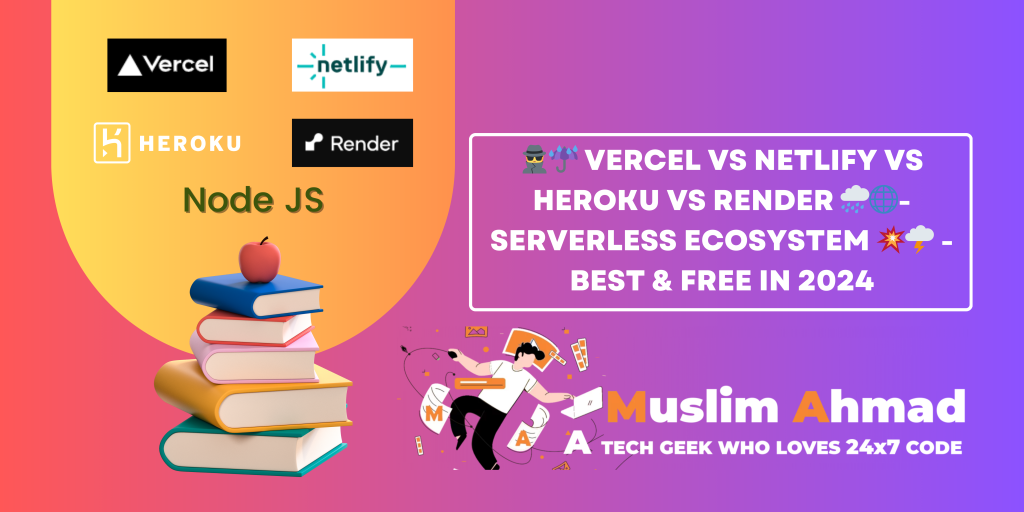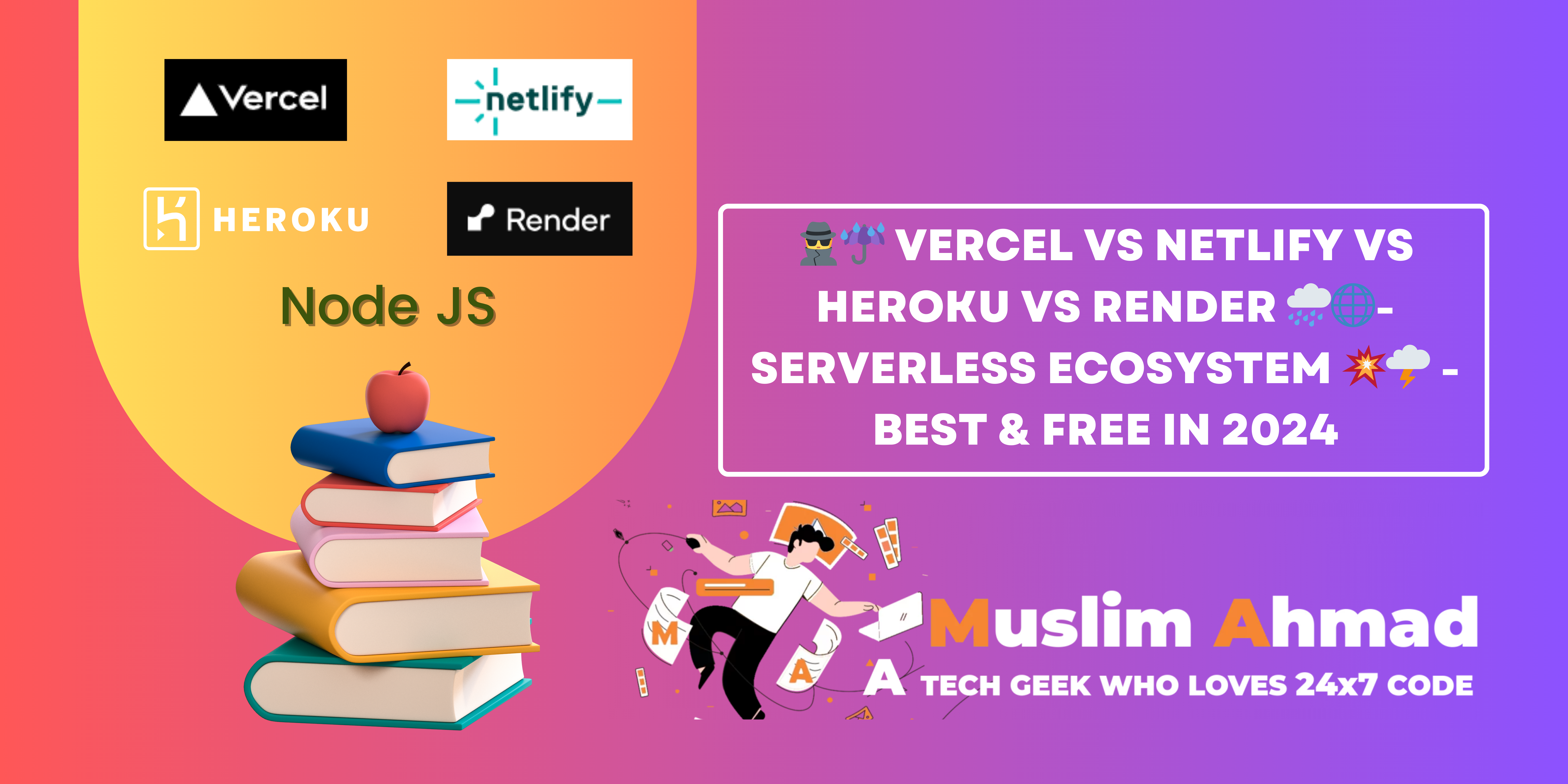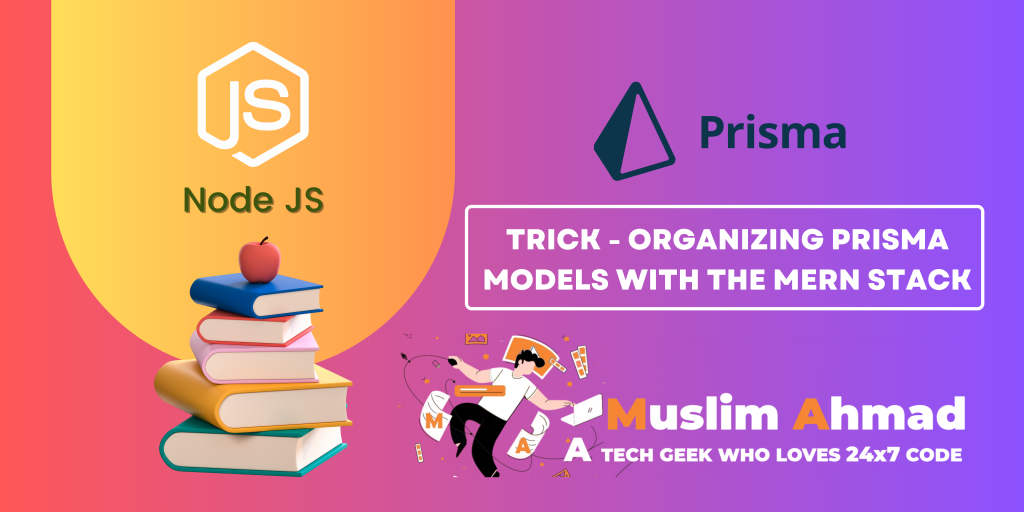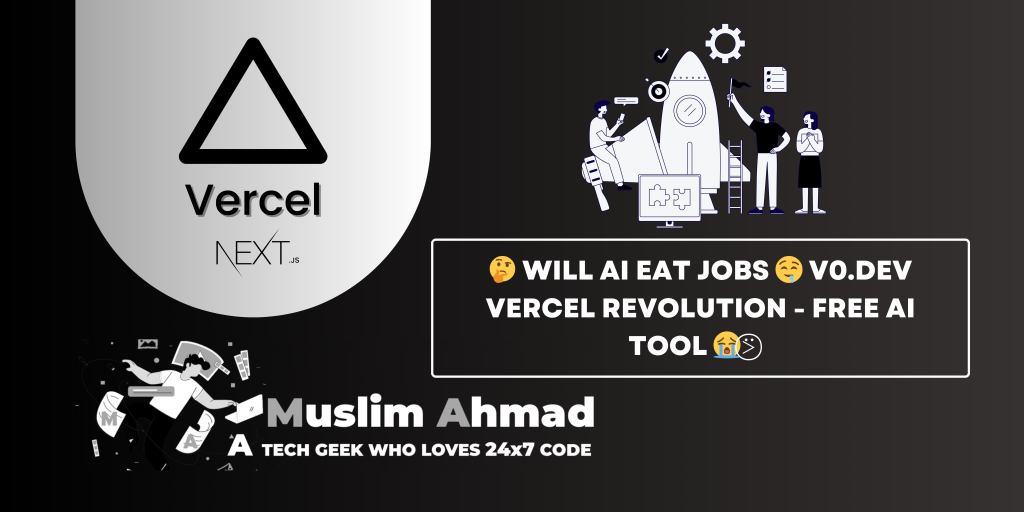In this blog, we will explore “🕵️☔ Vercel vs Netlify vs Heroku vs Render 🌧️🌐- Best Serverless Ecosystem 💥🌩️”. Here, this blog covers all topics like Introduction, Tech Stacks, Price & Plans about Vercel vs Netlify vs Heroku vs Render and many other things. Let’s dive in and check it out:

Introduction – Vercel vs Netlify vs Heroku vs Render – Serverless Ecosystem
The Serverless Ecosystem has revolutionized web development, offering developers an efficient and scalable way to deploy applications without the hassle of managing servers. Among the popular platforms in this space, Vercel vs Netlify vs Heroky vs Render stand out. Each of these platforms offers unique features and capabilities tailored to different development needs. This blog will provide an in-depth comparison of Vercel, Render, Netlify, and Heroku to help you choose the right platform for your next project and also with these platform’s plans & pricing.
Vercel
Overview
Vercel, formerly known as Zeit, is a platform designed for frontend frameworks and static sites, built to integrate seamlessly with headless content management systems (CMS). It focuses on performance and user experience, providing a global edge network to deliver sites and applications at lightning speed.
Key Features
- Automatic Deployments: Vercel supports automatic deployments with every code push.
- Serverless Functions: Easily deploy serverless functions alongside your static sites.
- Global CDN: Vercel’s edge network ensures your content is delivered quickly worldwide.
- Preview Deployments: Each pull request gets a unique URL for previewing changes before merging.
- Integrations: Extensive integrations with GitHub, GitLab, and Bitbucket.
Pros
- Optimized for frontend performance.
- Excellent developer experience with seamless integration.
- Preview deployments for collaborative review.
Cons
- Limited to static sites and serverless functions.
- Advanced features may require a learning curve for beginners.
Vercel’s revolutionary product and event details can be found at the link below:
👨🏻💻 How to use v0.dev Vercel – Free Revolutionizing AI Tool 🎉🤩 – #18
Revolutionary Event – Vercel Ship 𓊝 Recap – #17
Netlify
Overview
Netlify is a popular platform for hosting static websites and serverless functions. It’s designed to integrate with modern build tools and workflows, providing a seamless and efficient development experience.
Key Features
- Continuous Deployment: Automated builds and deployments from Git.
- Serverless Functions: Deploy functions alongside static content.
- Form Handling: Built-in form handling without the need for a backend.
- Split Testing: A/B testing for comparing different versions of your site.
- Netlify CMS: Headless CMS for managing site content.
Pros
- Excellent support for static sites and Jamstack architecture.
- User-friendly interface with powerful features.
- Free tier with generous limits.
Cons
- Limited to static sites and serverless functions.
- Custom configurations might require additional setup.
Heroku
Overview
Heroku is one of the oldest and most popular Platform-as-a-Service (PaaS) providers, known for its ease of use and powerful features. It supports a wide range of programming languages and is ideal for deploying dynamic applications.
Key Features
- Ease of Use: Simple deployment process using Git.
- Extensive Language Support: Supports various languages like Ruby, Node.js, Python, Java, and more.
- Add-Ons Marketplace: Wide range of add-ons for databases, monitoring, caching, and more.
- Scalability: Easily scale applications vertically and horizontally.
- Managed Services: Automated management of underlying infrastructure.
Pros
- Wide language support and flexibility.
- Large ecosystem with numerous add-ons.
- Mature platform with extensive documentation and community support.
Cons
- Higher cost for scaling applications.
- Limited free tier compared to competitors.
Render
Overview
Render is a unified platform to build and run all your apps and websites with free SSL, a global CDN, private networks, and auto-deploys from Git. It supports both static sites and dynamic applications, offering a flexible and comprehensive solution for modern development needs.
Key Features
- Automatic Deployments: Continuous deployment from GitHub and GitLab.
- Web Services: Run web applications with support for various languages and frameworks.
- Static Sites: Host static sites with free SSL and CDN.
- Background Workers: Run background jobs for processing tasks.
- Managed Databases: Easily deploy and manage databases.
Pros
- Supports both static and dynamic applications.
- Comprehensive platform with various services (web, background workers, databases).
- Simple and intuitive user interface.
Cons
- Newer to the market, which might mean fewer community resources.
- Some advanced features are behind higher pricing tiers.
Tech Stacks Comparison – Vercel vs Netlify vs Heroku vs Render
Here’s a detailed comparison of the tech stacks supported by Vercel vs Netlify vs Heroku vs Render as of 2024:
Vercel
Supported Tech Stacks:
- Frontend Frameworks: Next.js, React, Angular, Vue.js, Svelte, and more.
- Backend Frameworks: Node.js, Python, Go, Ruby.
- Static Site Generators: Gatsby, Hugo, Jekyll, Next.js (Static Export).
- Databases: Vercel recently added support for databases like PostgreSQL through Vercel Postgres, and integration with external databases via partners like Supabase and PlanetScale.
Netlify
Supported Tech Stacks:
- Frontend Frameworks: React, Vue.js, Angular, Svelte, Next.js, and more.
- Static Site Generators: Gatsby, Hugo, Jekyll, Eleventy, Next.js (Static Export).
- Serverless Functions: JavaScript (Node.js), Go.
- Backend Integrations: Can connect to any backend via API, commonly used with headless CMSs like Contentful, Sanity, and databases through third-party services.
Heroku
Supported Tech Stacks:
- Languages: Node.js, Ruby, Python, Java, PHP, Go, Scala, Clojure.
- Frameworks: Supports any web framework within these languages (e.g., Django for Python, Rails for Ruby).
- Databases: PostgreSQL, Redis, Apache Kafka, MySQL (via ClearDB), MongoDB (via third-party add-ons).
- Buildpacks: Extensive support for custom buildpacks to handle almost any other language or framework not natively supported.
Render
Supported Tech Stacks:
- Languages: Node.js, Python, Go, Ruby, Elixir, Rust, PHP.
- Frameworks: Supports any web framework within these languages.
- Static Site Generators: Hugo, Jekyll, Gatsby, and others.
- Databases: PostgreSQL, Redis, MySQL.
- Docker: Full support for Docker, enabling deployment of any application that can run in a container.
Here is a detailed table comparing the tech stack support for Vercel vs Netlify vs Heroku vs Render:
| Feature | Vercel | Netlify | Heroku | Render |
|---|---|---|---|---|
| Frontend Frameworks | Next.js, React, Angular, Vue.js, Svelte, etc. | React, Vue.js, Angular, Svelte, Next.js, etc. | React, Angular, Vue.js, Ember.js, etc. | React, Vue.js, Angular, Svelte, Ember.js, etc. |
| Backend Frameworks | Node.js, Python, Go, Ruby | Serverless functions with Node.js, Go | Node.js, Ruby on Rails, Python, Java, PHP, Go, Scala, Clojure | Node.js, Python, Ruby on Rails, Go, Elixir, Rust, PHP |
| Static Site Generators | Gatsby, Hugo, Jekyll, Next.js | Gatsby, Hugo, Jekyll, Eleventy, Next.js | Any static site generator with appropriate buildpacks | Hugo, Jekyll, Gatsby, Next.js, etc. |
| Serverless Functions | JavaScript (Node.js), Python, Go, Ruby | JavaScript (Node.js), Go | Yes (via add-ons or third-party) | JavaScript (Node.js), Python, Ruby, etc. |
| Databases | Vercel Postgres, Vercel KV, Vercel Blob | Third-party integrations (e.g., Fauna, MongoDB Atlas) | Heroku Postgres, Redis, MongoDB, ClearDB MySQL, Kafka | PostgreSQL, MySQL, Redis, MongoDB |
| Other Integrations | Redis, Analytics, CMS (Contentful, Sanity), etc. | Forms, Analytics, CMS (Contentful, Sanity), etc. | Extensive add-ons for various services like Redis, Kafka | Redis, Elasticsearch, RabbitMQ, custom integrations |
| Docker Support | Limited | No | Yes | Yes |
Summary
- Vercel is ideal for frontend-heavy applications and static sites, with strong support for serverless functions and recently added database options like Vercel Postgres.
- Netlify is focused on Jamstack architectures and static site deployments, with solid support for serverless functions and third-party backend integrations.
- Heroku offers extensive support for a wide range of programming languages and frameworks, making it suitable for full-stack applications. It also provides a rich ecosystem of add-ons for databases and other services.
- Render provides a versatile platform supporting various programming languages, frameworks, and databases, along with Docker support for customizable deployments.
These platforms cater to different needs based on their tech stack support, with Vercel and Netlify excelling in frontend and static site deployments, while Heroku and Render offer broader language and backend support.
Plans & Pricing
Let’s compare the plans and pricing for Vercel vs Netlify vs Heroku vs Render. Here are the pricing plans for Vercel vs Netlify vs Heroku vs Render as of the latest updates:
Vercel
- Hobby: Free
- 1 User
- Unlimited websites and serverless functions
- 100 GB bandwidth
- 1000 build minutes/month
- Pro: $20/user/month
- 1 Team member
- Unlimited websites and serverless functions
- 1 TB bandwidth
- 10,000 build minutes/month
- Enterprise: Custom pricing
- Unlimited team members
- Enterprise-grade support and features
- Custom bandwidth and build minutes
Netlify
- Free
- 1 GB bandwidth
- 100 GB storage
- 50 build minutes/month
- 1,000 requests
- Basic: $9/site/month (billed annually)
- 50 GB bandwidth
- 5 GB storage
- 100 build minutes/month
- 50,000 requests
- Advanced: $29/site/month (billed annually)
- 100 GB bandwidth
- 25 GB storage
- 350 build minutes/month
- 1,000,000 requests
- Pro: $49/site/month (billed annually)
- 1 TB bandwidth
- 100 GB storage
- 600 build minutes/month
- 5,000,000 requests
Heroku
- Free
- 550 dyno hours/month
- 1 web/worker dyno
- Free SSL
- Hobby: $7/dyno/month
- 1 web/worker dyno
- Custom domains
- Standard 1X: $25/dyno/month
- 1 web/worker dyno
- Performance monitoring
- Performance: $250/dyno/month
- Dedicated performance dynos
- 24/7 support
Render
- Free
- 100 GB bandwidth
- 512 MB RAM
- Free SSL
- Starter: $7/month
- 2 GB RAM
- 100 GB bandwidth
- Standard: $25/month
- 4 GB RAM
- 200 GB bandwidth
- Pro: Custom pricing
- Custom resources and bandwidth
- Dedicated support
These are the latest pricing details available from the respective official sources.
Pricing & Plans Comparison Table
Comparison Table Summarizing the Pricing and Plans for Vercel vs Netlify vs Heroku vs Render as of June 2024:
| Plan | Vercel | Netlify | Heroku | Render |
| Free | Free | Free | Free | Free |
| – 1 User | – 1 GB bandwidth | – 550 dyno hours/month | – 100 GB bandwidth | |
| – Unlimited websites and serverless functions | – 100 GB storage | – 1 web/worker dyno | – 512 MB RAM | |
| – 100 GB bandwidth | – 50 build minutes/month | – Free SSL | – Free SSL | |
| – 1000 build minutes/month | – 1,000 requests | |||
| Basic | $9/site/month (billed annually) | $7/dyno/month | $7/month | |
| – 50 GB bandwidth | – 1 web/worker dyno | – 2 GB RAM | ||
| – 5 GB storage | – Custom domains | – 100 GB bandwidth | ||
| – 100 build minutes/month | ||||
| – 50,000 requests | ||||
| Standard | $20/user/month | $29/site/month (billed annually) | $25/dyno/month | $25/month |
| – 1 Team member | – 100 GB bandwidth | – 1 web/worker dyno | – 4 GB RAM | |
| – Unlimited websites and serverless functions | – 25 GB storage | – Performance monitoring | – 200 GB bandwidth | |
| – 1 TB bandwidth | – 350 build minutes/month | |||
| – 10,000 build minutes/month | – 1,000,000 requests | |||
| Pro | $49/site/month (billed annually) | $250/dyno/month | Custom pricing | |
| – 1 TB bandwidth | – Dedicated performance dynos | – Custom resources and bandwidth | ||
| – 100 GB storage | – 24/7 support | – Dedicated support | ||
| – 600 build minutes/month | ||||
| – 5,000,000 requests | ||||
| Enterprise | Custom pricing | Custom pricing | Custom pricing | Custom pricing |
| – Unlimited team members | – Contact for enterprise features | – Enterprise-grade features | – Dedicated infrastructure and support | |
| – Enterprise-grade support and features | – Premium support | – Custom SLAs | ||
| – Custom bandwidth and build minutes | – Custom SLAs | – Compliance and audit features |
Summary
- Vercel offers a free plan with generous limits on bandwidth and build minutes, with Pro and Enterprise plans providing enhanced support and features.
- Netlify focuses on offering flexible site-specific plans with incremental pricing based on bandwidth, storage, build minutes, and requests.
- Heroku is versatile with a range of plans from free dyno hours to high-performance dedicated dynos, suitable for both small projects and enterprise applications.
- Render provides competitive plans with the option for highly customizable deployments and enterprise-grade support.
Conclusion
Choosing the right platform depends on your specific needs and the nature of your project:
- Vercel is ideal for frontend-focused projects and static sites that prioritize performance and simplicity.
- Render offers a versatile platform suitable for both static and dynamic applications with robust features.
- Netlify excels in static site hosting and serverless functions, perfect for Jamstack architectures.
- Heroku provides a flexible and powerful platform for dynamic applications with extensive language support and a rich ecosystem of add-ons.
Each platform offers a variety of plans to cater to different needs, from free tiers for small projects to enterprise plans with advanced features and support. Vercel and Netlify excel in hosting static sites and serverless functions with robust CDNs, while Render offers a more comprehensive solution with managed databases and flexible pricing. Heroku remains a strong choice for dynamic applications with extensive add-ons and language support. Evaluate your project’s requirements, budget, and desired features to select the platform that best aligns with your goals. Each of these platforms has its strengths, and understanding them will help you make an informed decision for your next serverless deployment. Choose the plan that best fits your project’s requirements and budget.
🤔 Will AI eat jobs 🤤 v0.dev Vercel Revolution – Free AI Tool 😭⍩⃝ – #19



